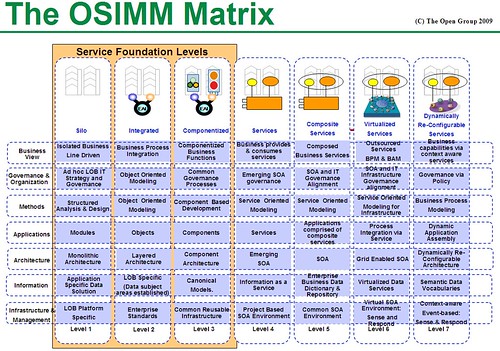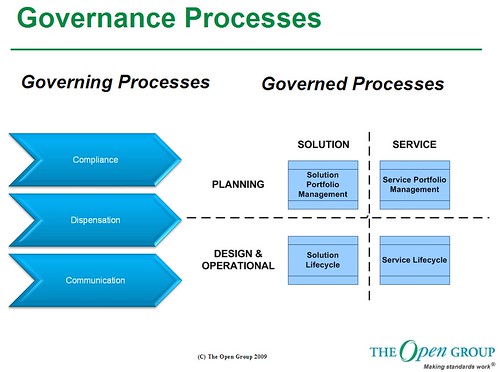I had a chance last week for a pre-release briefing from The Open Group’s Chris Harding, Forum Director for SOA and Semantic Interoperability, on two new standards that they are releasing today: the Service Integration Maturity Model (OSIMM) and the SOA Governance Framework. These are both vendor-neutral (although several large vendors were involved in their creation), and are available for free on The Open Group’s site. In their words:
OSIMM will provide an industry recognized maturity model for advancing the continuing adoption of SOA and Cloud Computing within and across businesses. The SOA Governance Framework is a free guide for organizations to apply proven governance standards that will accelerate service-oriented architecture success rates.
OSIMM is a strategic planning tool: it is used to assess where you are in your SOA initiatives relative to a standard, vendor-neutral maturity model, and help create a roadmap for how to move on to the higher levels of maturity. At the heart of it is the OSIMM matrix, with maturity levels as columns progressing from left to right, and the different organizational dimensions being measured as rows: business view, governance and organization, methods, applications, architecture, information, and infrastructure and management.
Within each cell of the matrix are the indicators for that dimension and maturity level: for example, if you’re using object oriented modeling methods, that indicates that your methods are at level 2, whereas using service oriented modeling would move you up to level 4 or 5 in the methods dimension. Behind this matrix, OSIMM includes a full set of maturity indicators and attributes, plus assessment questions that organizations can use to determine where they are in terms of maturity: each dimension can be (and likely will be) at a different level of maturity.
This has the potential to be an incredibly useful self-assessment tool for organizations: rather than the very product-specific measurements that you see from vendors (“Not using our product? Oh, you’re not at all advanced in your SOA efforts…”), this is independent of whatever products that you’re using: it’s more about the type of products, and the methods and governance that you’re using to apply them. You’ll be able to use it to understand services and SOA, assess the maturity of your organization, and develop a roadmap to reach your goals.
The first version of the OSIMM Technical Standard will be available here for free download, although that link was still not working at the time that I wrote this. Other industry-specific standards organizations are free to use OSIMM directly, or extend it with their own dimensions and indicators as required.
The other major announcement today is about the SOA governance framework, which helps an organization to define their governance processes and methods. This is more of a practical framework for defining policies aligned between business and IT, aiding communication and capturing vendor-neutral best practices. This includes best practices around both lifecycle management and portfolio management, for both services and service-based solutions.
Lifecycle and portfolio management are quite different: for example, a service lifecycle would include the idea or motivator for the service, the service definition, service creation, putting the service into operation, modifying and maintaining the service, and eventually retiring the service from operation. Service portfolio management is more concerned with reusability, and the practice of looking in the portfolio in the early stages of service lifecycle to see if there is an existing service that suits the requirements. The same applies to solution lifecycle and portfolio management; this differs from any other type of solution governance since there may be service-specific issues such as composition to be considered.
This generic reference model for SOA governance is provided as a standard, to be used by companies to create (and constantly monitor and update) their own specific governance model and best practices. The SOA governance framework may be used in the context of another governance framework, such as COBIT or ITIL; the SOA working group did a mapping of COBIT to this framework as part of the framework development process, and plan to do more in the future in order to help organizations preserve their investment in COBIT/ITIL training and implementation.
The SOA Governance Framework will be available here for free download.



Thanks for sharing! Very good information.
Regards,
Mike Walker
By comparing this early feedback and the now published SOA Source Book by The Open Group, i would be eager to propose some update (cf last paragraph, at the end of the post) : the framework by The Open Group should help companies to create their own specific governance “regime”, or “regimen” as per the The Open Group documentation.
The introduction of [governance ] “regime” in place of “model and best practices” leads naturally to the need to manage the life cycle of the regime, which is exactly what the SOA Governance Vitality Method (SGVM) is about.